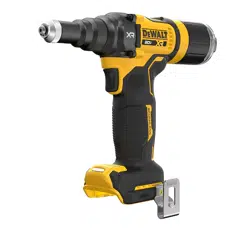Loading ...
Loading ...
Loading ...

9
ENGLISH
Belt Clip (Fig. F)
WARNING: To reduce the risk of serious personal
injury, ensure the screw holding the belt clip issecure.
IMPORTANT: When attaching or replacing the belt clip
19
,
use only the screw
20
that is provided. Be sure to securely
tightenscrew.
If the belt clip is not desired at all, it can be removed from
thetool.
To remove the belt clip, remove the screw
20
that holds the
belt clip inplace.
Mandrel Collector and Spare Nose piece
Holder (Fig. E)
WARNING: Do not use the tool without the mandrel
collectorattached.
The mandrel collector
5
and spare nose piece holder
6
attach to the rear of the tool.
The tool can be used without the spare nose pieceholder.
To remove the mandrel collector or spare nose piece holder,
unscrew them until they are removed. If you are using the
tool with the spare nose piece holder, attach it to the tool
first, and then attach the mandrelcollector.
Rivet Size Chart
Rivet Diameter
Nose piece mm Inches
DCF403
1 2.4 3/32
2 3.2 1/8
3 4.0 5/32
4 4.8 3/16
DCF414
A 4.8 3/16
B 6.0 15/64
C 6.4 1/4
Mounting the Nose piece (Fig. D)
1. Select the correct nose piece for the rivet to be installed.
Refer to the number or letter
14
on the nose piece and
the Rivet Size Chart to select the proper nose piece for
theapplication.
2. Unscrew and remove the screw cap
2
.
3. Place the nose piece
1
into the nose housing
3
.
4. Screw the screw cap onto the nosehousing.
ASSEMBLY AND ADJUSTMENTS
WARNING:
To reduce the risk of serious personal
injury, turn unit off and
remove the battery pack
before making any adjustments or removing/
installing attachments or accessories. An accidental
start‑up can causeinjury.
Wall Mounting
Some DeWALT chargers are designed to be wall mountable
or to sit upright on a table or work surface.If wall mounting,
locate the charger within reach of an electrical outlet, and
away from a corner or other obstructions which may impede
air flow. Use the back of the charger as a template for the
location of the mounting screws on the wall. Mount the
charger securely using drywall screws (purchased separately)
at least 1” (25.4mm) long, with a screw head diameter of
0.28–0.35” (7–9mm), screwed into wood to an optimal
depth leaving approximately 7/32” (5.5 mm) of the screw
exposed. Align the slots on the back of the charger with the
exposed screws and fully engage them in theslots.
SAVE THESE INSTRUCTIONS FOR
FUTURE USE
will turn on automatically when the battery pack needs to
becooled.
Never operate the charger if the fan does not operate
properly or if ventilation slots are blocked. Do not permit
foreign objects to enter the interior of thecharger.
Electronic Protection System
Li‑ion tools are designed with an Electronic Protection
System that will protect the battery pack against overloading,
overheating or deep discharge. The tool will automatically
turn off and the battery pack will need to berecharged.
Important Charging Notes
1. Longest life and best performance can be obtained if
the battery pack is charged when the air temperature is
between 65° F – 75° F (18° C– 24° C). DO NOT charge
when the battery pack is below 40° F (4.5° C), or above
104° F (40° C). This is important and will prevent serious
damage to the batterypack.
2. The charger and battery pack may become warm to the
touch while charging. This is a normal condition, and
does not indicate a problem. To facilitate the cooling of
the battery pack after use, avoid placing the charger or
battery pack in a warm environment such as in a metal
shed or an uninsulatedtrailer.
3. If the battery pack does not charge properly:
a. Check operation of receptacle by plugging in a lamp
or other appliance;
b. Check to see if receptacle is connected to a light
switch which turns power off when you turn out
thelights;
c. If charging problems persist, take the tool, battery
pack and charger to your local servicecenter.
4. You may charge a partially used pack whenever you
desire with no adverse effect on the batterypack.
Charger Cleaning Instructions
WARNING:Shock hazard. Disconnectthe charger
from the AC outlet before cleaning. Dirt and grease
may be removed from the exterior of the charger using
a cloth or soft non‑metallic brush. Do not use water or
any cleaningsolutions.
Loading ...
Loading ...
Loading ...
